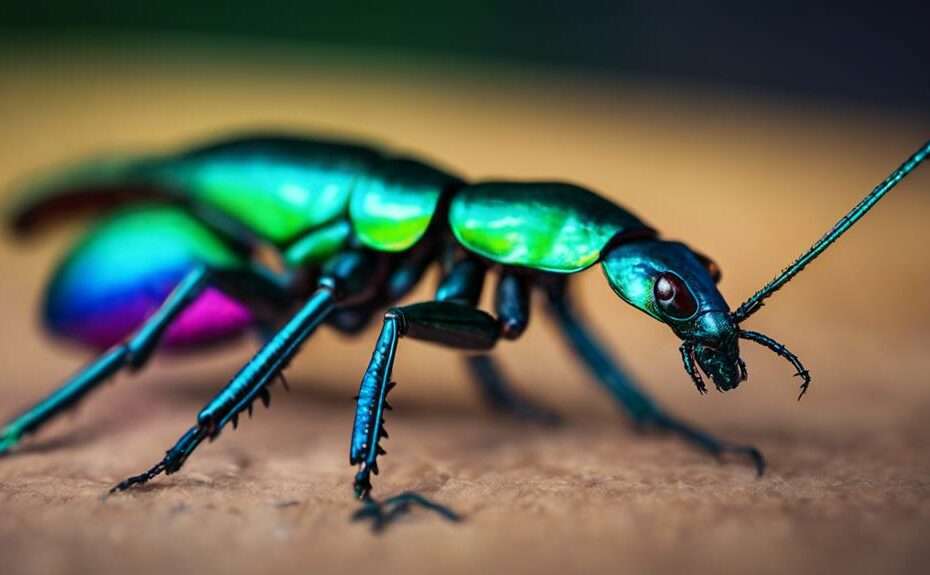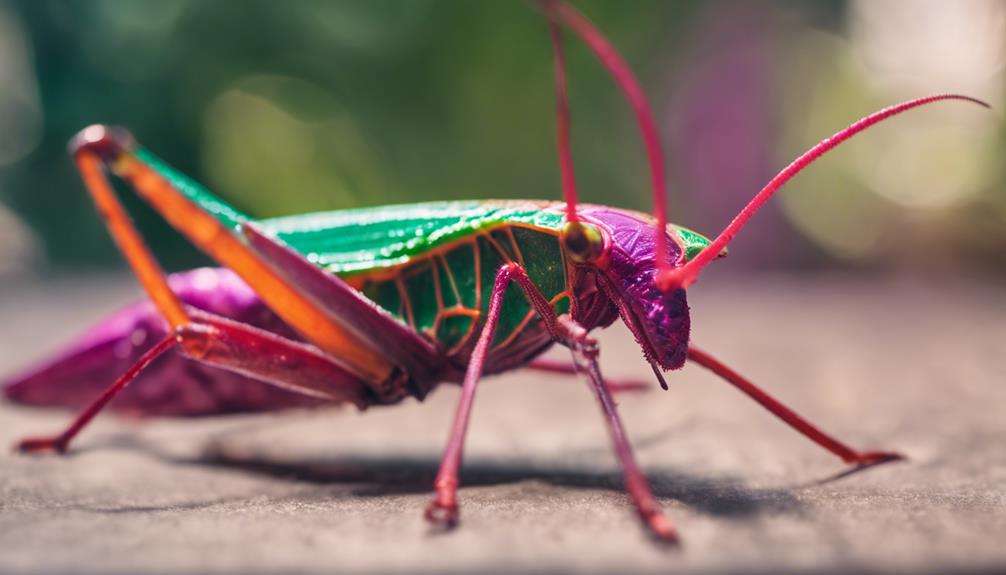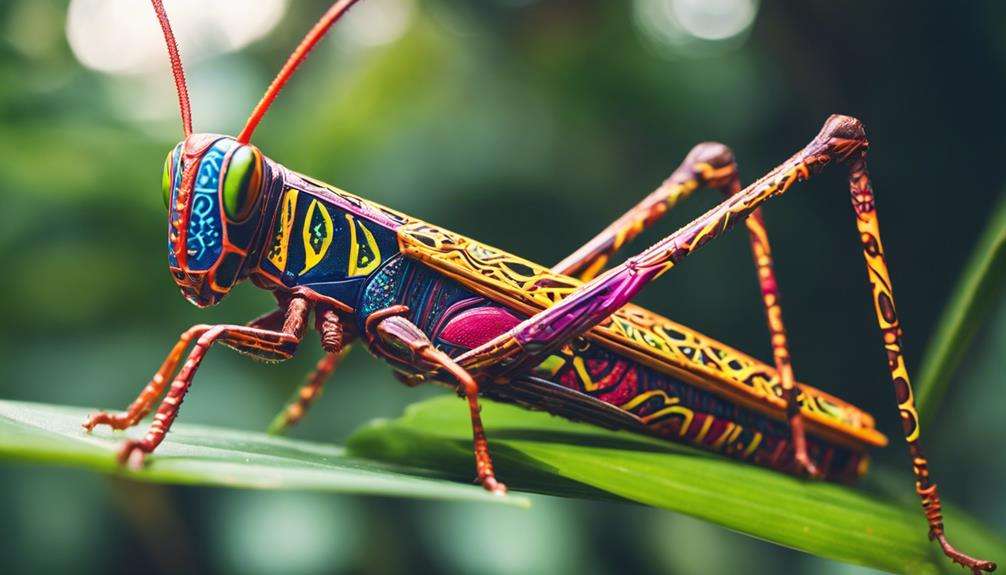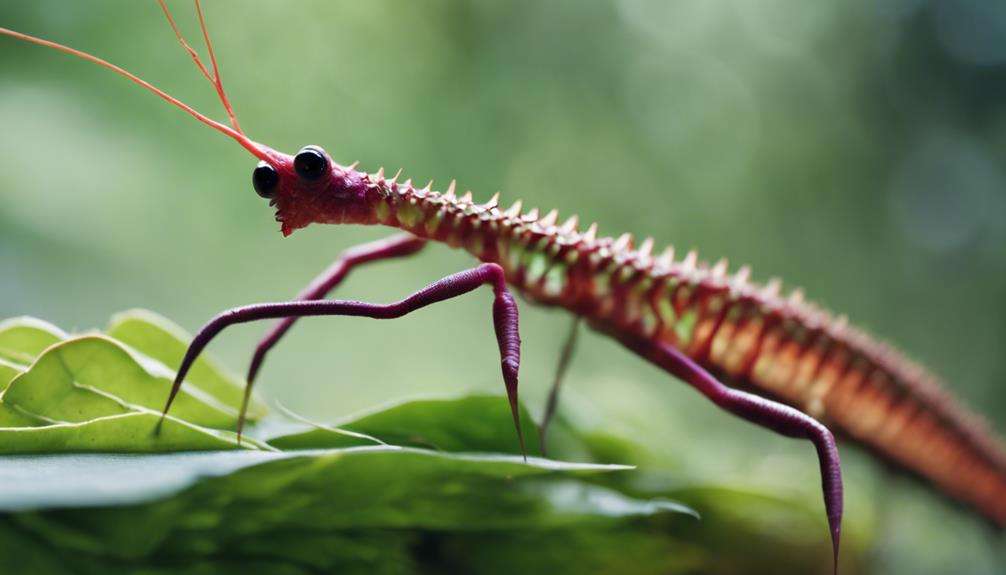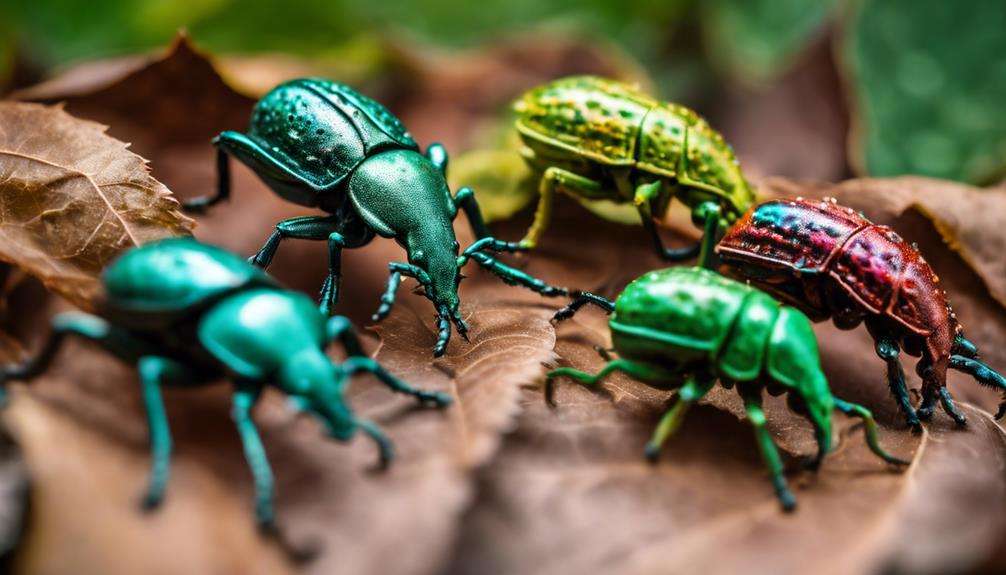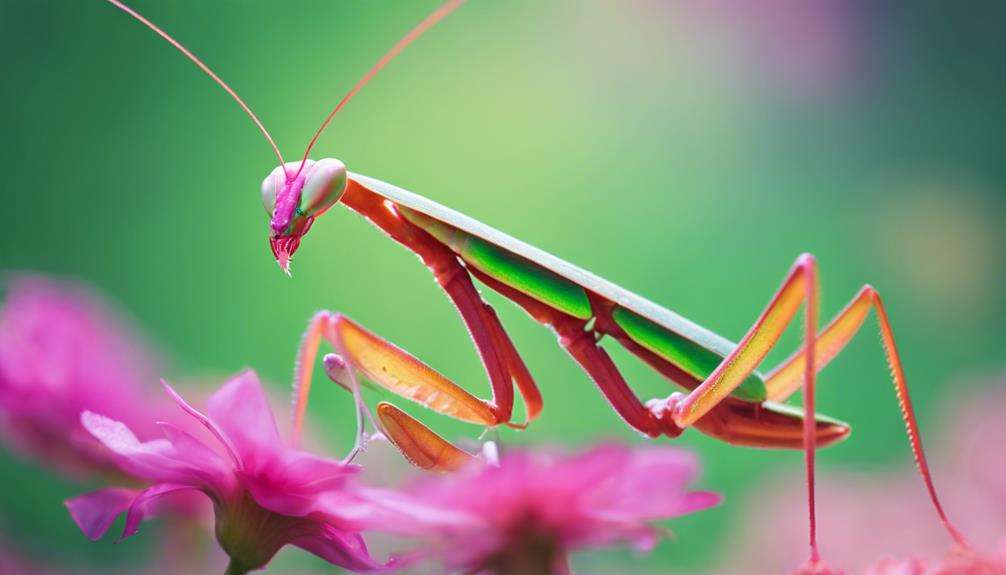If you're looking to add a touch of uniqueness to your insect collection, 'variety is the spice of life.' Imagine discovering exotic stick insects, uncommon leaf insects, rare tarantula varieties, and even quirky Madagascar hissing cockroaches available for adoption.
The Bugs In Cyberspace online store offers a fascinating array of unusual insect species waiting for a new home. Explore the world of bugs beyond the ordinary and uncover a hidden realm of insect diversity that might surprise you.
Key Takeaways
- Exotic stick insects and leaf insects offer unique mimicry and care requirements for adoption.
- Rare tarantula varieties support conservation efforts through adoption.
- Bizarre beetle options provide diverse characteristics and vibrant colors for adoption.
- Praying mantis species showcase evolutionary brilliance and fascinating adaptations for adoption.
Exotic Stick Insects
Exotic stick insects, renowned for their uncanny resemblance to sticks and twigs, captivate enthusiasts with their intricate mimicry and diverse species within the phasmid family. As a pet bug enthusiast, you'll be fascinated by the variety of insects that fall under this category. These insects, also known as walking sticks, are masters of disguise, blending seamlessly into their surroundings to avoid predators.
Keeping exotic stick insects as pets requires attention to detail. Providing spacious enclosures with ample vertical space is crucial for their molting and climbing needs. When it comes to their diet, these insects thrive on fresh leaves, with preferences varying among species. Eucalyptus, bramble, oak, and rose leaves are commonly enjoyed by these remarkable creatures.
Observing exotic stick insects in their habitat reveals a world of camouflage and intriguing behaviors. Their ability to mimic sticks and twigs with such precision showcases the wonders of evolution. Delve into the world of these captivating insects to witness nature's remarkable adaptations up close.
Uncommon Leaf Insects
Uncommon Leaf Insects exhibit a unique appearance, resembling actual leaves to perfection. Their behavior involves staying motionless to blend seamlessly with their surroundings, a defense mechanism against potential threats.
Care for these insects involves providing a spacious habitat with foliage for camouflage and a diet of leaves and berries for sustenance.
Leaf Insect Appearance
Resembling real leaves with remarkable accuracy, leaf insects, also known as walking leaves, exhibit a masterful camouflage strategy to evade predators in their natural habitats. Their flattened body structure, adorned with leaf-like veins and patterns, allows them to blend seamlessly into foliage.
Ranging in size, some species can grow up to 4 inches long, mirroring various leaf types. The slow, deliberate movements and swaying behavior of leaf insects further enhance their leaf-like illusion, making them incredibly difficult to spot. These herbivorous creatures primarily feed on fresh leaves, sustaining their unique appearance.
Observing a leaf insect is like finding an insect that embodies the leaf it needs to live amongst, showcasing nature's incredible adaptability and ingenuity.
Leaf Insect Behavior
Closely observing the behavior of uncommon leaf insects reveals a fascinating insight into their intricate adaptation strategies for survival in their natural habitats.
3 Fascinating Behaviors of Uncommon Leaf Insects:
- Camouflage Techniques: Uncommon leaf insects, similar to stick insects, exhibit remarkable leaf-like camouflage to blend seamlessly with their surroundings, evading predators effectively.
- Mimicked Feeding: These insects mimic their wild counterparts by primarily feeding on berries and leaves, showcasing a behavior that mirrors their natural feeding habits.
- Fascinating Adaptations: Their specialized adaptations not only aid in camouflage but also make them intriguing subjects for observation and study, attracting insect enthusiasts to appreciate their unique appearance and behavior.
Leaf Insect Care
In observing the intricate care requirements for uncommon leaf insects, one must ensure providing spacious containers mimicking their natural habitat to support their unique camouflage and feeding behaviors. Leaf insects reproduce through sexual reproduction, with females laying eggs that resemble plant seeds.
During the molting process, these insects shed their exoskeleton to grow, requiring a secure environment with appropriate humidity levels. Their camouflage techniques, mimicking leaves to evade predators, make them fascinating subjects for study.
To ensure their well-being, offer a diet of berries and leaves while creating a habitat that includes ample foliage and branches for perching and hiding. By replicating their natural surroundings, you can provide these captivating leaf insects with a comfortable and thriving environment.
Rare Tarantula Varieties
Delve into the world of rare tarantula varieties available for adoption, each boasting unique features and conservation significance.
- Tarantula conservation efforts: Rare tarantula varieties like the Gooty sapphire tarantula and the Ornithoptera allottei are crucial to conservation efforts. Their presence on conservation lists such as CITES highlights the need for protection due to their dwindling populations in the wild.
- Rare tarantula adoption benefits: By adopting these rare tarantula varieties, you not only gain a fascinating arachnid companion but also directly contribute to conservation efforts. Your support can help ensure the survival of these unique species for future generations to appreciate.
- Tarantula rarity awareness: Supporting the adoption of rare tarantula varieties raises awareness about the importance of protecting endangered insect species. These unique arachnids serve as ambassadors for their fragile ecosystems, highlighting the delicate balance of nature and the need for preservation. Joining in the adoption of these rare tarantula varieties can spark conversations and actions towards safeguarding our biodiversity.
Unique Praying Mantis Species
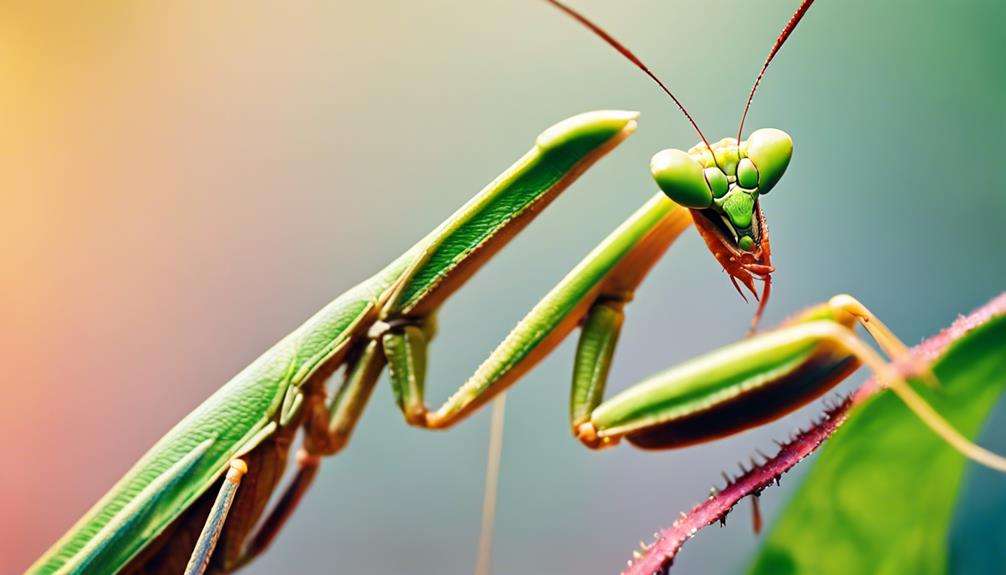
As we shift our focus to the realm of unique praying mantis species, one can't overlook the fascinating diversity and intricacies these remarkable insects exhibit.
The Orchid Mantis stands out for its behavior, mimicking flowers to attract prey before swiftly capturing them with its raptorial forelegs.
In contrast, caring for the Ghost Mantis involves providing a habitat that allows for its exceptional camouflage abilities to shine, blending seamlessly into its surroundings with its translucent, ghostly appearance.
The Spiny Flower Mantis captivates with its striking appearance, adorned with colorful markings and spiky extensions that resemble floral structures, aiding in its camouflage amidst vegetation.
Each of these species showcases adaptations that highlight the evolutionary brilliance of praying mantises, from deceptive behaviors to specialized appearances that serve both predatory and defensive purposes.
Whether observing the Orchid Mantis' hunting technique, ensuring the Ghost Mantis' habitat matches its ethereal appearance, or marveling at the Spiny Flower Mantis' intricate camouflage, these unique species offer a glimpse into the fascinating world of praying mantises.
Bizarre Beetle Options
When considering bizarre beetle options for adoption, you'll encounter a diverse array of unique beetle characteristics.
From the impressive size of Goliath beetles to the vibrant colors of rainbow stag beetles, each species offers a fascinating glimpse into the world of exotic insect pets.
As you embark on the beetle adoption process, remember to research proper care tips to ensure the well-being of these intriguing creatures.
Unique Beetle Characteristics
With their kaleidoscope of colors and intricate patterns, beetles present a fascinating array of options for those seeking unique and visually captivating insect companions. When exploring the world of beetles, you may encounter:
- Colorful beetle patterns: Beetles showcase a remarkable spectrum of hues and designs on their exoskeletons, from metallic blues to vibrant reds, making them stand out in any collection.
- Bioluminescent beetle species: Some beetles possess the extraordinary ability to emit light, creating a mesmerizing display that adds a magical touch to your insect habitat.
- Unique beetle behaviors: Certain beetle species exhibit intriguing behaviors like mimicry or complex mating rituals, offering insight into the diverse and fascinating world of insect interactions. These characteristics make beetles not only visually stunning but also intellectually stimulating insect companions.
Beetle Adoption Process
Consider the array of bizarre beetle options available for adoption, each offering a unique and captivating addition to your insect collection.
When it comes to beetle habitat preferences, it's crucial to replicate their natural environment as closely as possible. Different species may require specific temperatures, humidity levels, and substrates to thrive.
Understanding beetle breeding techniques is essential for those interested in expanding their collection. Some beetles lay eggs, while others undergo complete metamorphosis.
To ensure beetle health and wellness, providing a balanced diet is key. Beetles may require a variety of foods, including small insects, seeds, or plants.
Regular monitoring of their environment and behavior is vital to catch any potential issues early on and ensure a long and healthy life for your adopted beetle.
Beetle Care Tips
Explore the intricate care requirements of these fascinating and unconventional beetle species to ensure their well-being and longevity in your care.
- Beetle habitat design: Create a habitat with space for burrowing and climbing to mimic their natural environment. Use substrate like peat moss or coconut fiber for burrowing, and add branches or logs for climbing opportunities.
- Beetle feeding techniques: Offer a varied diet including small insects, seeds, and plants to meet their nutritional needs. Consider supplementing with calcium-rich foods like cuttlebone for species that require extra nutrients.
- Beetle breeding tips: Research specific breeding requirements for your beetle species, including temperature and humidity preferences. Provide separate breeding chambers if housing multiple beetles to prevent stress and ensure successful mating.
Strange Doodlebug Types
Among the myriad of fascinating insect species, peculiar types of Doodlebugs exhibit distinct characteristics that intrigue both researchers and enthusiasts alike. These sand dwelling marvels, also known as antlion larvae, are pit digging wonders.
Doodlebugs showcase remarkable behaviors by constructing pit traps in sandy environments to capture their prey, primarily small insects like ants. The antlion mysteries unfold as these larvae patiently wait at the bottom of their pits, ready to strike at unsuspecting victims that venture too close. This predatory strategy not only sustains the doodlebugs but also aids in controlling ant populations within their natural ecosystems.
Observing these peculiar creatures in action provides a glimpse into the intricate and efficient mechanisms they employ for survival. The symbiotic relationship between doodlebugs and their sandy habitats highlights the delicate balance within nature's intricate web.
Quirky Madagascar Hissing Cockroaches
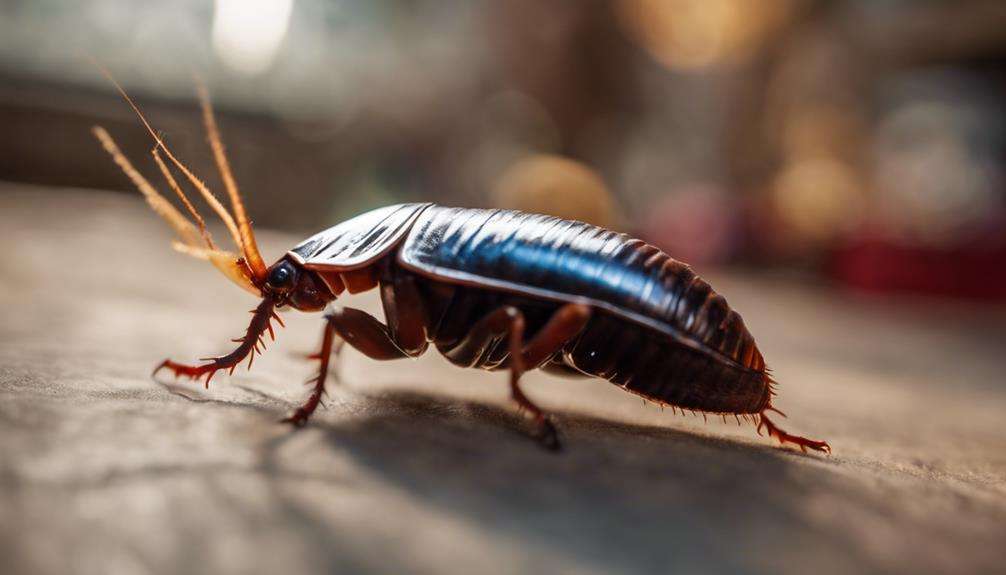
Pivoting from the intriguing behaviors of Doodlebugs, the spotlight now shifts to the captivating world of Quirky Madagascar Hissing Cockroaches, known for their unique characteristics and gentle demeanor. These fascinating insects offer a delightful opportunity for observation and care, with their intriguing habits and easy-to-manage nature.
Key Points about Madagascar Hissing Cockroaches:
- Hissing Cockroach Handling Techniques
Madagascar Hissing Cockroaches are generally docile and can be handled with care. Their hissing behavior when disturbed adds an interesting element to their interaction.
- Cockroach Breeding Habits
Breeding these cockroaches can be a straightforward process if the right conditions are provided. Females give birth to live young, and maintaining a suitable environment is crucial for successful reproduction.
- Cockroach Environmental Enrichment Techniques
To keep these creatures happy and healthy, providing enrichment activities such as climbing structures and hiding spots can simulate their natural habitat and promote their well-being.
Observing and caring for Madagascar Hissing Cockroaches can offer a unique and rewarding experience for insect enthusiasts seeking a distinctive pet.
Odd Cricket Variants
Uncommonly observed in the realm of entomology, peculiar cricket variants showcase remarkable genetic adaptations that set them apart from their more conventional counterparts.
One fascinating example is the Pink Katydid, which owes its unique pink coloration to a rare genetic mutation. These striking insects stand out amidst the greens of their habitats, making them a subject of intrigue for researchers and enthusiasts alike.
Moving to East Africa, the Blue Kubwa crickets sport vibrant blue hues, a mesmerizing sight in the wild.
Despite its misleading name, the Jerusalem cricket isn't a true cricket but rather belongs to the group of insects known as 'potato bugs.' This misconception has led to confusion about its classification among some observers.
Exploring the diverse world of cricket variants reveals a tapestry of genetic diversity and adaptations that continue to captivate those delving into the intricacies of insect biology.
Unusual Ant Species
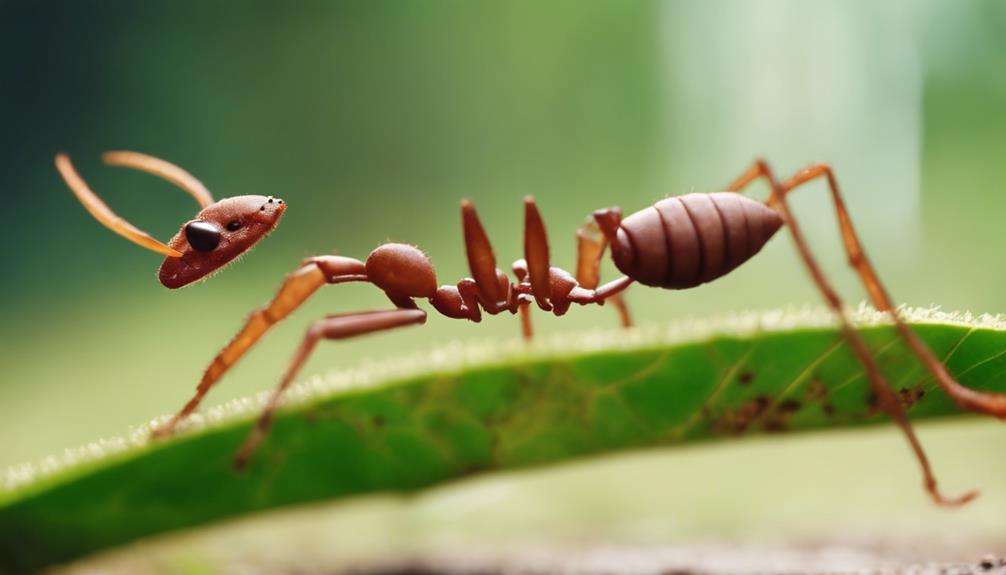
Observing the intricate behaviors and unique adaptations of unusual ant species provides a fascinating glimpse into the diverse world of these industrious insects.
- Ant Venom Effects: Unusual ant species like the Bullet Ant (Paraponera clavata) possess venom that causes intense pain lasting up to 24 hours, earning them a fearsome reputation in the insect world.
- Ant Farming Techniques: Leafcutter ants (Atta and Acromyrmex species) are known for their advanced farming practices where they cultivate fungus for food, showcasing a remarkable level of agricultural sophistication within their colonies.
- Ant Colony Migration: The nomadic behavior of Army ants (Eciton species) leads to the formation of massive colonies containing millions of individuals, demonstrating coordinated migration patterns that are essential for their survival in ever-changing environments.
Each of these unusual ant species offers a unique perspective on the complexities of ant behavior, from potent venom effects to intricate farming techniques and massive colony migrations. Studying these ants not only expands our understanding of their world but also highlights the remarkable diversity and adaptability of these tiny yet fascinating creatures.
Frequently Asked Questions
What Is the Most Unusual Insect?
The most unusual insect showcases strange behaviors, exotic appearances, and unique adaptations. Observing such specimens can offer insights into fascinating evolutionary paths and intricate ecological roles. Explore the world of insects to uncover their remarkable diversity.
What Is the Rarest Insect to Find?
Seeking rare insect species can be a fascinating journey. Hard to find bugs like the Gooty sapphire tarantula and Cyprus beetle are unique insect varieties that capture attention. Their rarity makes them prized possessions for enthusiasts.
Can You Adopt an Insect?
Yes, you can adopt unique insect species. Adopting exotic bugs provides insight into their fascinating world. Benefits of insect adoption include supporting conservation, educational opportunities, and raising awareness about the importance of these creatures in ecosystems.
What Is the Best Bug to Have as a Pet?
When considering the best bug for a pet, explore exotic beetle species, unique mantis breeds, and fascinating cockroach varieties. Each offers distinct characteristics and care needs, making them intriguing choices for bug enthusiasts.
Conclusion
You've explored the fascinating world of unusual insect species available for adoption at Bugs In Cyberspace. Did you know that the Vinegaroon, a unique arachnid species, can live up to 10 years in captivity? Imagine observing its intriguing behavior and distinctive appearance for a decade in your own home.
With such captivating creatures to choose from, the possibilities for expanding your insect collection are truly endless.
